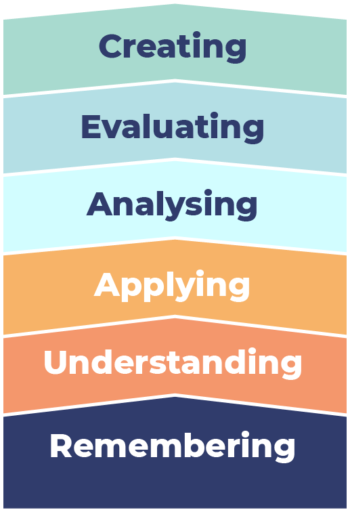The revised taxonomy provides an easy to follow guide for creating learning objectives that are aligned to various learning levels.
What is Bloom’s Taxonomy?
Originally developed in the 1950s by a team headed by Benjamin Bloom, Bloom’s Taxonomy consisted of six levels of learning for the cognitive domain (internal knowledge). This work was expanded into two additional domains: psychomotor (physical skills) and affective (emotions or attitude). The Cognitive Taxonomy became a standard tool in the creation of learning objectives by learning designers but it had some limitations. These were addressed in the Revised Bloom’s Taxonomy in 2000.

The Revised Taxonomy consists of the following six learning levels:
- Remembering — the lowest level of learning that include recognising or recalling facts from memory.
- Understanding — learning by interpretation, classification, summarising, comparing or explaining the content.
- Applying — learning by implementing or executing actions.
- Analysing — learning by differentiating, organising, or attributing.
- Evaluating — learning by checking or critiquing.
- Creating — learning by generating, planning or producing.
In addition to the six levels of learning, there are four levels of knowledge. These consist of:
- Factual Knowledge — includes basic facts and terms related to your industry.
- Conceptual Knowledge — general theories and models relevant to your industry.
- Procedural Knowledge — knowledge of techniques required for a particular role.
- Metacognitive Knowledge — reflecting on your own thinking.
Why use Bloom’s Taxonomy
It is essential that learning objectives – tied to performance improvement – are considered and articulated early during a learning project. Learning content, activities, and ultimately assessment items should all align to set learning objectives. Building these clear learning objectives assist in the planning of your course.
How to use the Taxonomy
Learning objectives usually contain a verb (an action the learner will do) and a noun (an object). You can choose from a list of suggested verbs for each section of the taxonomy to assist in the creation of your objectives. These verbs can then guide you in building appropriate learning activities and assessment items that address your objectives.
The revised model extends this process by combining the Cognitive and Knowledge dimensions together in a matrix. By cross-referencing the type of learning against the type of knowledge, specific verbs are suggested that correspond to appropriate learning activities.
How not to use the taxonomy!
Learning objectives should underpin your course design but the ideal audience for a formal learning objective is the instructional designer, not the learner. The resulting objectives can be a little abstract if they are offered as a list of bullet points at the start of a digital learning module. An effective method for starting a module is to present a goal to be reached or a problem that requires resolution.
Helps you to write focused learning objectives. An essential part of the Instructional Design toolkit. “
Review

Pros: Assistance in the creation of learning objectives.
Cons: Output can be a little abstract for the learner.
Key features:
- Six learning categories
- Four knowledge levels
- List of active verbs for each learning category
- A trusted tool used by instructional designers
Related reading: Gagne, Merrill, Instructional Design
